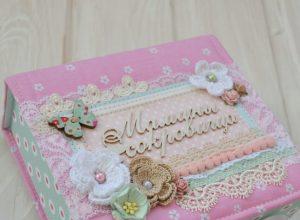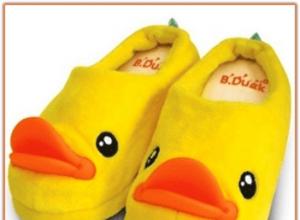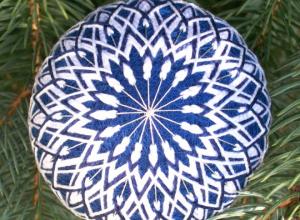How to choose a good jacket for the winter for a child. How to choose the right winter jacket for a child? Outer jacket fabric
Babies grow very quickly, so the question of what winter clothes to choose for a child is faced by parents almost every season. But it’s one thing when a baby snores peacefully in a stroller, and quite another when it comes to choosing a jacket for a little tomboy.
Young researchers do not like to walk quietly - they are attracted by puddles and dirty thawed patches. Therefore, dad and mom should take care of practical winter clothes that will not be afraid of moisture and frequent washing. A high-quality and functional jacket for a child is an essential component of a comfortable and safe walk.
 Size of children's winter jacket You can buy children's winter jackets without trying them on if you do not have the opportunity to take your child shopping. To choose suitable outerwear, you need to know the size chart, the height of the child or the size of a jacket that has only recently become small.
Size of children's winter jacket You can buy children's winter jackets without trying them on if you do not have the opportunity to take your child shopping. To choose suitable outerwear, you need to know the size chart, the height of the child or the size of a jacket that has only recently become small.
Many items indicate the height and age for which the jacket is designed. Winter clothing for boys and girls should reach mid-thigh. The sleeves of the jacket should completely hide children's fists from the frost. A very comfortable model - a jacket with adjustable cuffs. Material for a child's winter jacket Modern synthetic fabrics with a membrane can perfectly retain heat. At the same time, they are very light, durable and practical. If you wish, you can buy a jacket whose surface is treated with special dirt-repellent and water-repellent compounds. Natural materials are preferable for lining - it is better if it is flannel or fleece. They are pleasant to the body, effectively remove excess moisture and retain heat.
Fiberdown or holofiber materials have proven to be the best filling for a child's jacket. As for traditional natural down jackets, they are suitable for short-term use, as they do not withstand washing very well.
 Tips for choosing children's jackets for the winter1. Jackets for kids with large plastic zippers have proven themselves to be excellent. This “snake” is easy to fasten even with mittens.
Tips for choosing children's jackets for the winter1. Jackets for kids with large plastic zippers have proven themselves to be excellent. This “snake” is easy to fasten even with mittens.
2. A mandatory attribute of a good jacket are spacious pockets. You can hide your favorite toy or put gloves there.
3. The hood will reliably protect your head from the wind, and to make it easy to wash, choose models with a detachable top. It is better if you buy a jacket for a child with a hood that is attached with a zipper: fasteners in the form of buttons or snaps are not so reliable.
4. Choose items with double collars to ensure your neck is well covered. However, make sure that the lock does not put pressure on your throat and chin.

5. Pay attention to jackets with knitted cuffs that will protect your arms from the penetration of cold. They are in very pleasant contact with the body and securely fix the sleeves.
6. It is advisable to choose outerwear with reflectors so that the baby can be clearly seen in the dark. In addition, such a patch is an excellent decoration for a jacket.
7. Today winter clothes are in fashion, which can easily be transformed into demi-season clothes if you remove the warm lining. This product is quite expensive, but it allows you to avoid unnecessary expenses in connection with the purchase of another jacket for the baby.
Caring parents always want their child to wear warm and comfortable winter clothes. Before choosing a children's jacket, make sure that it is the right size for your baby. It is also worth paying attention to the presence of such little things as pockets, a hood, a high collar and reflective elements.
Katerina Vasilenkova
Parents face this problem almost every year.
If a baby sleeps peacefully in a stroller during walks, that’s one thing, but if he spends his time actively, that’s completely different.
Once a child has learned to walk, he rarely walks quietly. All the guys are simply attracted to thawed patches, mud and puddles. Therefore, parents should give preference to practical clothes that are not afraid of moisture and wash well.
A children's winter jacket is an essential component of a successful, comfortable and safe walk.
How to choose a winter jacket for a child?
1. Pay attention to the size
Of course, if you cannot take your child with you to the market or to the store, you can buy a children’s winter jacket without trying it on, but it is better for the child to put on the jacket before purchasing it, because only in this way can you really assess its size and then, how she sits on the baby.
In addition, outerwear should be comfortable and convenient, and these parameters can only be assessed during fitting.
If you are going to buy a winter jacket yourself, without a toddler, be sure to measure his height and the size of the jacket, which has become too small for him.
Very often, on clothing, manufacturers indicate the age for which the item is designed. This also helps determine the size.
When buying a children's winter jacket, pay attention to the fact that it should reach mid-thigh. This is the best option. And the sleeves should hide children's fists without much effort.
A model with adjustable cuffs is considered comfortable.
2. Pay attention to the material
It is believed that clothes made from natural materials are best suited for children. But, in the case of children's winter jackets, this is not entirely true. Today, winter children's clothing uses synthetic fabrics that retain heat well. At the same time, they are not expensive, lightweight, practical and durable.
It’s good when natural materials are used to make the lining. They retain heat, remove excess moisture, and are pleasant to the body.
Please note that if your child gets very dirty during a walk, you can choose a jacket whose surface is treated with a special water- and dirt-repellent compound.
As for fillers, holofiber and fiberdown have proven themselves well.
If you like jackets made from natural down, then when purchasing them you should remember that they are not durable because they do not tolerate washing well.

How to choose a winter jacket for a child? Helpful Tips:
1. It's good if the jacket has large pockets. You can hide mittens (gloves) or your favorite toy in them.
2. A children's jacket that has a large plastic zipper is considered comfortable. It is easy for a child to fasten it even with gloves.
3. Don’t forget that it is important to have a hood in winter jackets. It is able to protect the child's head in strong winds and precipitation. To make the hood easy to wash, buy a jacket in which it can be easily unfastened. It is very convenient when the hood is fastened with a zipper.
4. When choosing a jacket, pay attention to the collar. After all, in winter, the neck should be completely covered.
5. Make sure that the zipper does not put pressure on your chin or scratch it.
6. Jackets with knitted cuffs are considered comfortable. They fit snugly to the body and protect your hands from the cold.
7. It's nice to have reflectors on your outerwear. Then the child can be clearly seen in the dark.
8. Pay attention to the practicality of the jacket, which consists in the possibility of transformation into a demi-season one. This is done very simply: by removing the lining and fur on the hood.
And remember that high-quality winter outerwear is the key to your baby’s health, so take your choice of a winter jacket seriously.
Read about how to choose winter shoes for children.

Many mothers argue which is better for the child: one-piece overalls or separate jacket and pants. After all, the overalls are so comfortable: nothing rides up, nothing blows. But jackets also have obvious advantages, for example, the ability to take them off in transport or indoors. The set can be washed separately (pants usually get dirty more). And one more significant advantage: the jacket will last longer than overalls. The Know How website will help you make the right choice.
When will you need your first jacket?
For babies under one year old, it is more convenient to use overalls in the warm season, and especially in winter. The first jacket will be needed when the baby begins to move actively.
Every season has its own jacket
When choosing any clothing for a child, you need to pay attention to the climate of your region.
For winter, choose the extended version: your baby will feel comfortable on the sled and on the slide.
A light, lined jacket will come in handy in the spring, when it's warm enough to break away from your winter clothes.
An unlined jacket, such as a denim one, will keep you warm on cool summer evenings.
In the fall, you will need a warm jacket with insulation and a good water-repellent top layer. This same jacket will come in handy in the spring, during the off-season.
For each season you need to buy two jackets: if one gets wet or dirty, a replacement will always be ready. You can create a wardrobe in such a way that jackets not only replace, but also complement each other - they can differ in insulation, length, etc.
Modern manufacturers produce children's outerwear with special impregnations and coatings that increase resistance to dirt and moisture penetration. After a walk, it is enough to clean such a jacket with a brush.
What requirements usually apply to a children's jacket?
1) it should be light, free, and not restrict movement. Do not forget that there should be room under the jacket for free movement of air;
2) the optimal length is slightly higher than the middle of the thigh in the back, the front of the jacket, due to the cut, can be shorter;
3) good thermal insulation. There should be a drawstring at the bottom of the jacket, and knitted cuffs inside the sleeves. This will not only save heat, but also protect against snow if a child, for example, decides to ride down a slide or play in the snow;
4) it is convenient if there is more than one fastener on the jacket: inside there is a zipper, on the outside there is a placket with buttons or buttons. This is additional protection from wind and bad weather;
5) the outer fabric of the jacket should be soft, not rustling. Clothes made from membrane materials are very practical; they allow air to pass through from the inside, which allows the child not to sweat, and from the outside they serve as a barrier to rain and snow;
6) the lining should be made of natural materials: cotton jersey, flannel, fleece. They are pleasant to the skin and, in addition, have good heat-saving and hygroscopic properties. Synthetic linings do not allow air to pass through well, making such clothes uncomfortable: cold in winter and hot in summer;
7) goose down or synthetic fillers are most often used as insulation. The latter are more practical, as they can withstand countless washes and are easy to store. It is better to buy children's clothing from well-known manufacturers with high-quality insulation;
8) the jacket’s insulation must be well quilted: the fluff will not collect in one place, and the synthetic fabric will better retain its shape;
9) try to choose a jacket with reflective stripes;
10) a hood with a drawstring along the outer edge is required; it will be convenient if it can be unfastened;
11) internal and external pockets – additional convenience for you and your child.
Overalls
Overalls are trousers with a chest, straps and sometimes with a back. This is a convenient option for winter and autumn - even if the jacket rides up, the baby will not be cold.
The trousers can have cuffs to adjust their length. The inside of the pants should have elasticated cuffs.
The overalls can be fastened in front with a zipper or on the sides with snaps or buttons.
The straps must be adjustable in length. It is convenient if they are fastened with carabiners with a latch.
Often, overalls are sold together with jackets. In this version, they will complement each other and match in color and design. In addition, the set will cost less than these two products separately.
Let's sum it up
1) The optimal age of a child to purchase the first jacket is 2-2.5 years.
2) For each season, choose the optimal model taking into account the climatic characteristics of your region.
3) When choosing a winter jacket, pay special attention to the quality of the insulation and how it is quilted.
4) Internal knitted cuffs will protect against snow and cold air.
5) Try to buy two jackets for each season so that you always have a replacement for soiled or wet clothes.
6) Overalls are very comfortable in the cold season.
A children's winter jacket should be comfortable, light and warm. These are the main criteria that you should consider when choosing outerwear for your baby. In addition to them, we would like to draw attention to a number of important nuances that will help you make the right choice.
Size
The ideal winter jacket for a child should be long enough to reach mid-thigh. It should not restrict movement, be too loose or too tight. There should be space inside for an air cushion. The right choice would be a model with the ability to adjust the size using various laces and belts. The bottom of the jacket should also be tied with a drawstring.
Upper layer
The outer fabric of the jacket should be water-repellent and airtight. Thanks to the “breathable” material, the child will not sweat. These requirements ensure that modern synthetic fabrics are durable and easy to care for.
Insulation
Today, goose down or special synthetics (fibertech, fiberdown) are usually used as filler. The latter option is more practical because it is easier to store and wash.
Lining
The preferred materials for lining are natural. It can be cotton knitwear, fleece or flannel. This fabric is pleasant to the touch and retains heat well. The insulation must be evenly quilted, otherwise the fluff will accumulate in one place, so the jacket will not keep warm and fit. A very useful feature is the removable lining, which allows you to easily turn a winter jacket into a demi-season one.
Clasp
In addition to the zipper, the jacket must have an additional top placket with buttons or snaps. As for the zipper, the zipper stroke should not be too tight or too light. Zippers with large straps and key rings with locks are very practical - they can be easily unfastened in the cold, even with gloves.
Cuffs
Knitted or knitted cuffs on the inside of the sleeves will protect the child from snow penetration, cold air and retain warmth under the jacket.
Collar
Models with a double collar are more preferable. Make sure that the collar does not cover the baby's mouth or rest against the chin. This design will certainly cause discomfort in the child. At the same time, the neckline should cover the child’s neck, so the best option is a low stand-up collar.
Pockets
Children cannot live without pockets in winter. External and internal pockets will definitely come in handy for the little one to store various extremely important little things.
Hood
This is a must-have item for a children's winter jacket. It is best if it is detachable. In this case, do not forget to check how firmly it holds when fastened. Please note that the hood with buttons will come off when you try to hold your little one by it. Therefore, the best choice is a zippered hood.
Reflective stripes
Such a detail will never be superfluous, since winter is not the brightest period of the year.
An interesting option is a practical reversible winter jacket. Your child will always have a choice of which jacket he would like to wear today.
You can either write your own.
Is winter boring, gray everyday life or days filled with joy and fun? It all depends on how you can organize your leisure time. Go with your children to the forest, sled down a hill, build a snowman, just don’t forget to warm yourself up. How to choose winter clothes for a child so that the baby is warm, dry and comfortable?It is impossible to clearly determine which winter clothes for children are the best. It all depends not only on the brand and material, but also on the individual characteristics of the child’s thermoregulation. Today, the choice of outfits for babies is so huge that mothers sometimes don’t know what to buy. What should you pay attention to?
Model
- For babies under one year old, it is better to buy an envelope: it is completely closed from the wind, giving the baby a feeling of security and comfort.
- For children over 12 months old, the best winter clothing is overalls. It is easy to put on a child, and the baby is comfortable in it.
- Don't know what to buy for a child who goes to kindergarten? Take a closer look at suits consisting of overalls and a jacket. And one more tip: comfort is important for preschoolers, so try to buy clothes that will not hinder movement. Modern technologies make it possible to create warm, but practically weightless things that perfectly retain heat. Clothes Reima, Huppa, Luhta, Icepeak, Lassie, Didriksons - you've probably heard a lot of praise about them.
Material
- The outer fabric must be durable: not to tear, stretch or deform from temperature changes and load.
- The outer layer must allow air to pass through, that is, allow the skin to breathe. Clothes should not so much warm as they should save heat through natural air exchange.
- The fabric from which children's clothing is made should be easy to care for: easy to wash and dry quickly.
- An additional layer is welcome in the area of the knees and buttocks, because these are precisely the places that “suffer” the most during walks. For example, winter overalls and trousers from Lassie can withstand even the most active outdoor play of children.
- If you're choosing a jacket or overalls, look at what the lining is made of. It can be nylon, cotton or fleece. The latter will provide warmth to the baby (subject to the correct selection of clothing underneath), and nylon guarantees the lightness of the product. . Modern lining materials are also good - fabric with small silver dots. It is used in production by leaders in the field of creating innovative clothing, for example, Columbia or Huppa, in particular the latter has a patented HuppaTec Lining technology. The action of this material is based precisely on the ability of small silvery inclusions to trap thermal radiation between the body and the fabric.
You need to pay attention to the lining not only in strategically important places, but also in the sleeves: the lighter the material, the freer the movement of the child’s hands. The same Huppa uses Taffeta fabric for these purposes - a synthetic material that is slippery to the touch.
- Popular brands can boast of the quality of seam processing: they are not only stitched, but also taped. This is a guarantee of dryness in any weather: moisture will not be able to penetrate under the clothes through the stitches. This technology is not that new. For example, the Didriksons company has been sewing clothes with “welded seams” since 1947 and every year the developments are only improving.

Insulation
What clothes should a child choose: insulated with time-tested natural fur or one in which modern materials provide warmth? This depends on two factors: how active the baby is during a walk and how the baby’s thermoregulation center works.
- Natural insulation materials used in modern models are down and wool. The first is represented by three types - eider (the warmest), goose and duck (not suitable for winter). Down clothes are very light, but at the same time this material is a strong allergen, so it is not suitable for all children. Sheepskin (wool) is considered a hypoallergenic material, so supporters of natural insulation prefer it. A lining or liner made of wool is good for newborn babies, but mothers of older children say that winter clothing made of sheepskin is impractical. The thing is that, despite its high threshold of thermal insulation, its main disadvantage is its weight: it is simply difficult for a child to run down the street in such uniforms.
- Sintepon– synthetic material made from polyester fibers. It has long been used in sewing winter clothes and has undergone many improvements throughout its existence. However, no matter how much experts strive to increase the level of thermal insulation of synthetic winterizer, this insulation can withstand frost of no more than -10°C.
- Holofiber and fibertek- These are artificial down substitutes. Inside they are an interweaving of siliconized spirals. Due to the voids, these materials retain heat well. Clothes made from holofiber and fibretek are very practical: the filling will not crumple after repeated washings and will retain its structure.
- Isosoft– another modern synthetic insulation that can withstand temperatures of -25°C. Its structure is several layers of spherical fibers separated by cavities. Isosoft is suitable for active children who love to frolic on walks in winter. Leading manufacturers use similar insulation in their products, and each has its own patented technology, for example, Luhta and IcePeak use Finnwad material. The main advantage of such insulation is lightness. The clothes will not be bulky, but your child will definitely not freeze in them.
- Membrane- also insulation, but not internal, but external. Modern mothers are very fond of membrane clothing, considering it the warmest, while forgetting the main condition for the “work” of this material - maximum movement. A membrane is a special film or impregnation applied to the outer surface of the product. Thanks to its tiny pores, it easily removes moisture from the inside, but is completely powerless against moisture from the outside. When it rains or snows, the drops will easily close the pores, and the work of the membrane will come to naught.
Comfort for the child
- Clasps. For small children, the ideal option is zippers.
- Sleeves. Winter children's clothing should have either a thick cuff or an elastic band at the bottom of the sleeve.
- Pants legs. There should be an elastic band along the bottom edge to prevent snow from getting into the boots. It would be good if there was a strip at the bottom of the trouser leg.
- Pockets. They are not necessary for the baby, but very convenient. You can put spare mittens or a handkerchief in them. When purchasing, pay attention to the location of the pockets so that snow does not accumulate in them during a walk.
- Anti-pollution. Rolling around in the snow, getting into the mud - children love all this very much. It’s a pity if after the first walk the fidget’s clothes lose their attractive appearance. What to do? Shouldn't we go for a walk? Walk, and as much as possible. Modern winter clothing is not afraid of dirt. For example, Reima sets and overalls are made of fabric coated with a protective layer, which is absolutely safe for children and at the same time repels dirt.
- Size. Each manufacturer has its own sizes. Conventionally, everyone adheres to the recommendation to buy sets, focusing on the child’s height and adding 6 cm to this indicator. There are clothes that grow with the child, for example, Didriksons sets and overalls: by opening the seam of the pleat on the lining, you can increase the length of the sleeves or legs.
Latest site materials
Cooking

An original birthday gift for a woman: ideas, options and recommendations
In this section we will talk about what to give a woman for her 45th birthday if you are her husband or loved one. Surely, you have already given her many original and not so little things. Perhaps some of them did not cause the expected reaction or, conversely, for a long time
Cosmetology

Nice blazers. Men's blazers. Black men's blazer. What colors does a red jacket go with?
The fashionable chic of modern times and the elegance of a uniform can be combined in the same model, if its prototype contains the features of the military uniform of past centuries. What is a blazer and how can you distinguish it from other types of clothing of a similar cut? At its core, m
Experience

06/21/2015 | 2203 Natalia Golubkova 06/21/2015 2203 The art of creating balls from threads - temari - was born in China, became traditional in Japan and today is of interest everywhere. It is believed that these bright “balls” bring
Comic gifts for a woman’s anniversary: how to congratulate her on her birthday in an original way
Cosmetology

Hello, our long-awaited day, We came here for a reason, The table is set, the glasses are poured, Maybe the October holiday? Maybe we'll celebrate the New Year? Or did Mai come here? We are celebrating our birthday... half a hundred and five There is a newborn among us We will congratulate all of her But, pi
Funny birthday greetings to a woman Happy 37th birthday to a woman

